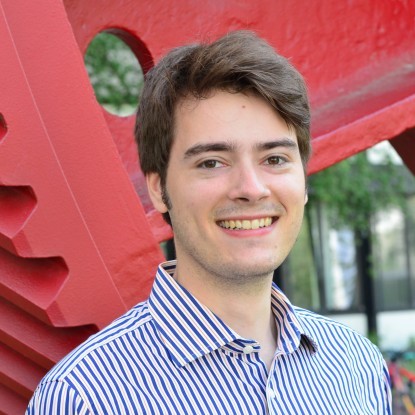

Robert Schmitz is a research associate (Ph.D. student) under the guidance of Dr.-Ing. F. Ferraro in the group of Prof. C. Hasse at the institute for Simulation of reactive Thermo-Fluid Systems (STFS) at TU Darmstadt. His research area is the modeling of soot formation. He is involved in several projects investigating soot formation in various applications, different fuels, and conditions. His main project covers the effect of alternative fuels such as oxymethylene ethers, which could be applied in self-ignition engines, on the reduction of soot particles in laminar and turbulent jet flames. Other projects investigate the soot formation under pyrolytic conditions and aim for a suitable model reduction for the application in 3D – CFDs of gasoline engines or, within the ESTiMatE project, the prediction of soot from aero-engines modeled in kerosene surrogate flames.
What is your motivation for pursuing research in this area?
Fluid dynamics, combustion, and especially soot formation are areas that combine various chemical and physical processes. The modeling of these simultaneously concurring phenomena adds some aspects of math and informatics. This mix of disciplines is fascinating for me since I learned about them in school for the first time and the interest grew during my studies as an engineer and the preparation of my bachelor and master thesis and continues unabated since then.
Soot particles are known to have a negative effect not only on climate warming due to an altered cloud formation or increased absorption of sunlight when soot is deposited on ice and snow surfaces but also on human health because of their respirable size. The research in the field of soot formation and thus improvements of combustion devices lead to a reduction of soot emissions which helps to tackle climate change, one of the most challenging problems of today’s society. Contributing with my research is an additional motivation that actuates me continuously.
What would you have done if you were not a researcher?
This is a question that is hard to answer because I do not know which opportunities would have opened up if I had not continued my research after I wrote my master thesis at STFS. Most probably I would be in the industry and would have tried to work on a similar topic.
Have you encountered any challenges in pursuing your research career?
Large parts of the code on which our soot models are based are written by a previous member of our group who finished his Ph.D. and left a few months before I started my studies. So, the possibility for an extensive knowledge transfer was quite limited. On the other hand, his work led to a great code foundation on which I could start my own soot simulations and directly focus on my research topics.
What do you do within the ESTiMatE project?
Within the ESTiMatE project, I am modeling the soot formation of laminar kerosene surrogate flames under various conditions which are experimentally measured by a project partner at KIT. We use a statistical approach to approximate the size distribution of the particles which is relevant for the individual soot processes themselves. The results of the applied soot model, the Split-based Extended Quadrature Method of Moments, are compared in the ESTiMatE project against a different kind of soot model, the Direct Sectional Method, which is developed in TU/e.
How do you like it so far?
ESTiMatE is a European project with many project partners. I really like the discussions and fruitful interaction with the international project partners so far and I am very happy to meet them at an upcoming project meeting in person since the current pandemic situation makes it possible now again after two years of online meetings.
Additionally, the project combines the investigation of different fuel components such as ethylene, iso-octane, and a kerosene surrogate under different flame conditions. This broad and at the same time very detailed analysis with a comparison of two soot models combined with numerous experimental measurements also really helps to compare and improve the soot models as well as getting a broader view of the soot formation topic in general.
What do you hope to achieve in your career in the long run?
I do not have a specific designation for my future career in mind. But I hope that I will still have the same passion which drives me and that I continue enjoying the research and the soot formation topic as much as I do right now.
